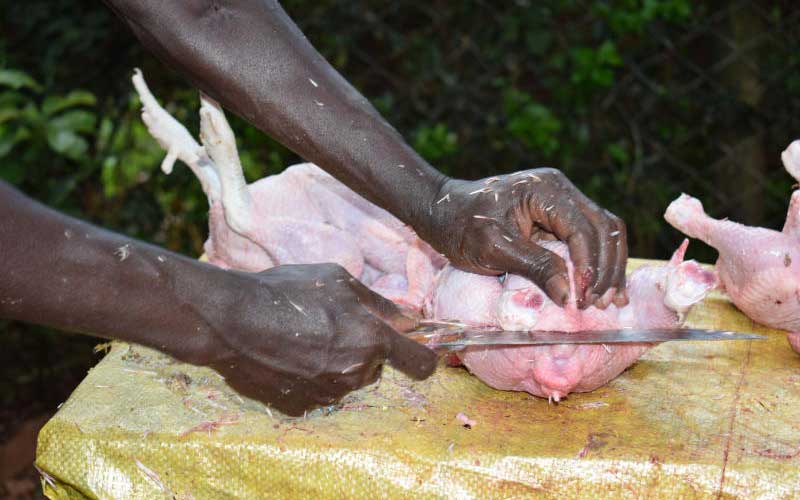Your step by step chicken processing

As we approach the festive season, 12 million broilers will be slaughtered and ready for consumption in the next three months. About 80 per cent of this number will go through informal slaughtering method as farm chicken while the others will be slaughtered through various licensed premises. On this note, my focus today is on tips on chicken slaughter and processing:
Feed withdrawal
It naturally takes approximately six hours to digest feed within the gastrointestinal tract of a chicken and therefore one needs to do feed withdraw between 6-12 hours before commencement of slaughter. This gives the gut time to clear all the ingesta in the rumen through digestion and assimilation and defecation prior to slaughter. However, water should be provided in plenty until time of slaughter. If feed is withdrawn less than 6 hours to slaughter, you risk spillage of faecal material on to the carcass during the process of evisceration (removal of the intestines and attached organs like liver). This will result into bacterial contamination and rapid spoilage of meat. If for some reason you delay slaughter and withdrawal period exceeds 12 hours, you will have loss of intestinal integrity lining and weakening of the membranes. During evisceration, the intestines are likely to rupture and spill the liquid ingesta and contaminate the carcass as well. It’s important that the withdrawal period is closely adhered to and farmers only carry this process once a confirmed order has been secured.
Catching & Transport
Catching birds for slaughter should be done during the cool part of the day or alternatively at night with a provision of blue lighting that helps in calming them down. This humane handling of birds ensures minimal flapping of the wings which may cause greening of deep pectoral muscles (Oregons disease) which will cause rejection at packing. Chickens are caught by holding both legs right above the feet and no more than three chickens should be carried in each hand. No dead bird should be slaughtered.
Stunning and bleeding
Its is good animal welfare practice to stun birds (rendered unconscious and unaware of pain) and then quickly and swiftly slaughter using a sharp knife on the throat. Let the bird completely bleed out for good preservation of the carcass and meat quality. Electrical stunning (110 volts) is most popular and ideal method recommended by industry regulators. It must be followed with slaughter within two minutes of stunning. However, one can do cervical dislocation of the neck if you have no access to electricity or alternatively use carbon dioxide gas to put the birds to sleep before slaughter. The advantage of gassing is that it does not lead to broken wings or hemorrhages in the breast and thigh muscles hence better quality compared to electrical stunning method. Place the birds on bleeding cones head first with both wings folded to prevent flapping and injuries.
Scalding and plucking
Using hot boiling water, the bird is completely immersed in this water to soften feathers making it easier to pluck and remove any soil or organic material on the skin. Plucking can be done by hand or using mechanical pluckers available in the market. The ideal temperature is about 140 0F.
Evisceration and cleaning
This is the process of removing all the internal organs from the upper buccal cavity that is wind pipe, oesophagus, crop, gizzards, liver spleen and the entire intestines carefully without spilling the contents on the carcass. A cut is made at the base of the tail above the vent from where a hand is introduced to grab the large intestines and other internal organs This is followed by thorough cleaning in portable chlorinated water to reduce any form of unintended contamination of the carcass.
Chilling and Freezing
Immediately after cleaning, chill the chicken in tank with water and packs of ice to a temperature of 40 0F within 4 hours to arrest any microbiological growth and improve on the shelf life of your chicken. The carcass is then removed from the chilling tank and drained before they are packed and stored in frozen state.
Value addition
You can add value by packing boneless portions, marination, cut-ups (8- or 10-piece cuts) and soup packs for the end market.
[The writer is a head vet at Kenchic]
Want to get latest farming tips and videos?
Join Us
Share this article on social
 The Standard Group Plc is a multi-media organization
with investments in media platforms spanning newspaper print operations,
television, radio broadcasting, digital and online services. The Standard Group
is recognized as a leading multi-media house in Kenya with a key influence in
matters of national and international interest.
The Standard Group Plc is a multi-media organization
with investments in media platforms spanning newspaper print operations,
television, radio broadcasting, digital and online services. The Standard Group
is recognized as a leading multi-media house in Kenya with a key influence in
matters of national and international interest.
 The Standard Group Plc is a multi-media organization
with investments in media platforms spanning newspaper print operations,
television, radio broadcasting, digital and online services. The Standard Group
is recognized as a leading multi-media house in Kenya with a key influence in
matters of national and international interest.
The Standard Group Plc is a multi-media organization
with investments in media platforms spanning newspaper print operations,
television, radio broadcasting, digital and online services. The Standard Group
is recognized as a leading multi-media house in Kenya with a key influence in
matters of national and international interest.







